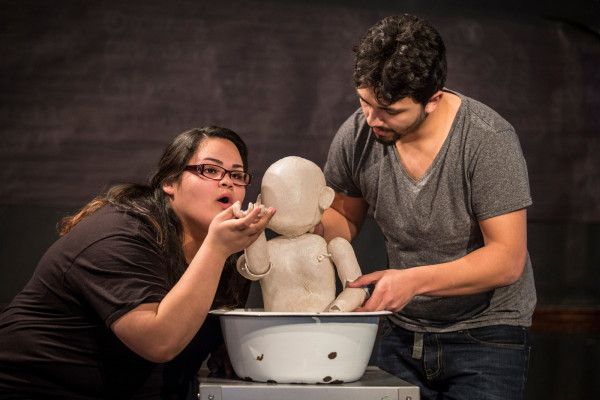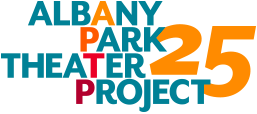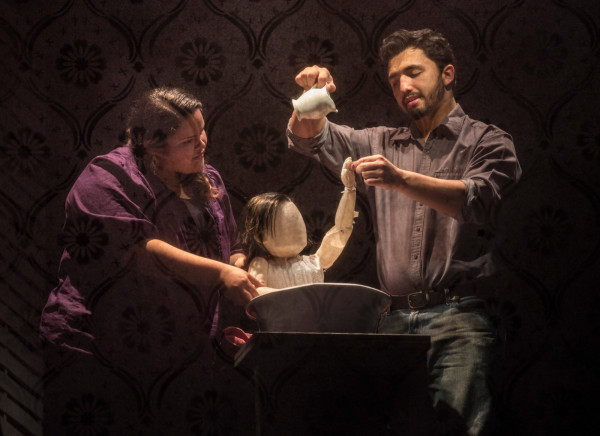You blink twice to make sure you’re not seeing things—the little toes and dimpled chin, youthful curiosity and playful humor. You begin to see how an object can be given life and personality. This isn’t an actor, but it is much more than a prop. In God’s Work, APTP is discovering the world of puppetry, and in the process, Baby Rachel—both the character and the puppet—has been born.

God's Work is Albany Park Theater Project's first production to feature bunraku-style puppetry. Pictured: Ely Espino and Jalen Rios. (Photo: Liz Lauren)
APTP has enlisted the expertise of puppetry designers Brandon Campbell and Lacy Katherine Campbell to create Baby Rachel. Bringing years of experience as artists and educators, Brandon and Lacy have not only designed and built Baby Rachel, but they have also taught APTP youth ensemble members how to give her life.
Creating Baby Rachel herself was a challenge, requiring hours of experimentation with fabrics, materials, and building techniques. Brandon and Lacy tested several machés in search of one that would allow for the puppet to have a magical quality while also withstanding months of rehearsals and performances (and any potential falls or stumbles). The key to mending Baby Rachel’s growing pains turned out to be a simple fabric hardener, Paverpol, to strengthen her form and make her stage worthy.

Rehearsals began in December 2013 to teach APTP’s youth artists what Lacy dubs the “micro movements” that make up Baby Rachel’s persona, including breath, focus, and fixed point. For those not of the puppetry world, focus relates to where the puppeteer has the puppet “look” and focus its attention, while fixed point is establishing gravity and weight for the puppet so that it is not simply floating in space.
APTP is using the Japanese style of Bunraku for Baby Rachel’s time on stage, which means the puppeteers are in plain sight of the audience. This creates a complexity that caters well to APTP’s storytelling, establishing opportunity for relationship building between characters. But it adds an extra challenge: actors must puppeteer and play characters simultaneously. In order to tackle this, Brandon and Lacy have focused on the dynamic between the cast and the puppet:
"The process has been very much about not only teaching them to be puppeteers but teaching them to function as caregivers, because that’s ultimately who they are playing."

APTP ensemble member Ely Espino, age 17, says she is learning to balance her role as both puppeteer and as Irene, Rachel’s aunt. Through various exercises and workshops, Ely discovered that a simple shift in her positioning and stance made all the difference: “I felt more like a puppeteer than my character because I stood behind the puppet, so I changed my position to stand next to the puppet and saw a huge difference in being able to connect with the other actors.”
For the cast members sharing scenes with Baby Rachel, delving into the world of puppetry was at first daunting, but the prospect of introducing a new art form to the APTP stage proved inspirational. The learning process has been built on baby steps to master the techniques of puppetry, especially breath. In one rehearsal, the actors were given prompts of different emotions (sad, happy, excited, fearful), and, for each emotion, they would breathe once with the emotion and once with the character to constantly stay connected to the puppet. Once Baby Rachel gained her breath, Ely and Jalen Rios, who plays Rachel’s uncle, worked on the how a real baby would move and crawl to understand how the puppet would move her body across the floor.

With time, Baby Rachel has become a part of the company and has grown into her personality. Ely recounts a bathtub scene in particular as a moment when Baby Rachel came to life, “You learn to love the puppet. You really need to take care of it, take it out of the tub, wrap it, dry it, help it heal. Like it’s a real baby.” Brandon and Lacy have also taught the ensemble members to always treat the puppet as though she were a real little girl, even outside of rehearsal time. Now, when you see ensemble members getting to know Baby Rachel, it looks as though they are sharing playtime with a younger sibling rather than exploring the characteristics of a new puppet.
We look forward to sharing Baby Rachel with the world when God’s Work begins performances at the Goodman Theatre on April 4, 2014. We hope you will join us and experience the magic of puppetry, storytelling, and imagination.
 Menu
Menu
